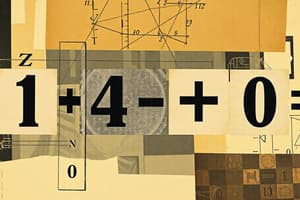Podcast
Questions and Answers
What is the result of subtracting a number from itself?
What is the result of subtracting a number from itself?
- The number itself
- A negative number
- Zero (correct)
- A positive number
Which subtraction strategy involves adjusting one number to simplify the problem?
Which subtraction strategy involves adjusting one number to simplify the problem?
- Breaking down numbers
- Using compensation (correct)
- Using number lines
- Counting up
In which situation would you use subtraction to find a solution?
In which situation would you use subtraction to find a solution?
- Counting the number of items bought
- Calculating the change after a purchase (correct)
- Finding the total cost of items
- Establishing a budget limit
Which of the following correctly represents the associative property in subtraction?
Which of the following correctly represents the associative property in subtraction?
What is required when the top digit in a column is smaller than the bottom digit during subtraction?
What is required when the top digit in a column is smaller than the bottom digit during subtraction?
Which strategy helps in visualizing numbers to support easier subtraction?
Which strategy helps in visualizing numbers to support easier subtraction?
What is a common misconception regarding the commutative property and subtraction?
What is a common misconception regarding the commutative property and subtraction?
Which statement about subtracting zero from a number is true?
Which statement about subtracting zero from a number is true?
Flashcards
Basic Subtraction
Basic Subtraction
Finding the difference between two numbers.
Subtraction Property (Zero)
Subtraction Property (Zero)
Subtracting a number from itself equals zero.
Subtraction with Borrowing
Subtraction with Borrowing
When top digit is smaller, borrow from next place value.
Commutative Property (Subtraction)
Commutative Property (Subtraction)
Signup and view all the flashcards
Subtracting Zero
Subtracting Zero
Signup and view all the flashcards
Word Problem Approach
Word Problem Approach
Signup and view all the flashcards
Mental Math (Counting Up)
Mental Math (Counting Up)
Signup and view all the flashcards
Subtraction with negative result
Subtraction with negative result
Signup and view all the flashcards
Study Notes
Basic Subtraction
- Basic subtraction involves finding the difference between two numbers.
- It is a fundamental arithmetic operation.
- Subtraction is the inverse operation of addition.
- Understanding place value is crucial for accurate subtraction.
- Subtraction with borrowing is necessary when the top digit in a column is smaller than the bottom digit.
- Subtraction with regrouping involves borrowing from the next higher place value.
Number Properties
- Commutative property does not apply to subtraction (e.g., 5 - 3 ≠ 3 - 5).
- Associative property does not apply to subtraction (e.g., (10 - 5) - 2 ≠ 10 - (5 - 2)).
- Subtraction of a number from itself always results in zero (e.g., 8 - 8 = 0).
- Subtracting zero from a number results in the same number (e.g., 12 - 0 = 12).
- Subtraction of a number from a smaller number gives a negative result.
Real-life Applications
- Calculating change in shopping situations.
- Determining the difference in distance between two locations.
- Finding the remaining amount of time available.
- Calculating cost savings after discounts are applied.
- Determining the amount of work left to be completed.
- Balancing budgets and tracking finances.
Word Problems
- Word problems are real-world situations that require the application of subtraction to find a solution.
- Read the problem carefully and identify the relevant information.
- Determine the required operation (in this case, subtraction).
- Solve the equation to find the answer.
- Check that the answer makes sense in the context of the problem.
Mental Math Strategies
- Counting up: Start with the smaller number and count up to the larger number, noting each step.
- Using compensation: Adjust one number strategically to make the subtraction easier.
- Breaking down numbers: Split each number into smaller parts and subtract sequentially.
- Using number lines: Visual representation of numbers that can support easier subtraction.
- Properties of numbers: Employ properties like additive identity to simplify the problem.
- Fact families: Utilize relationships between addition and subtraction to derive answers faster.
Studying That Suits You
Use AI to generate personalized quizzes and flashcards to suit your learning preferences.




